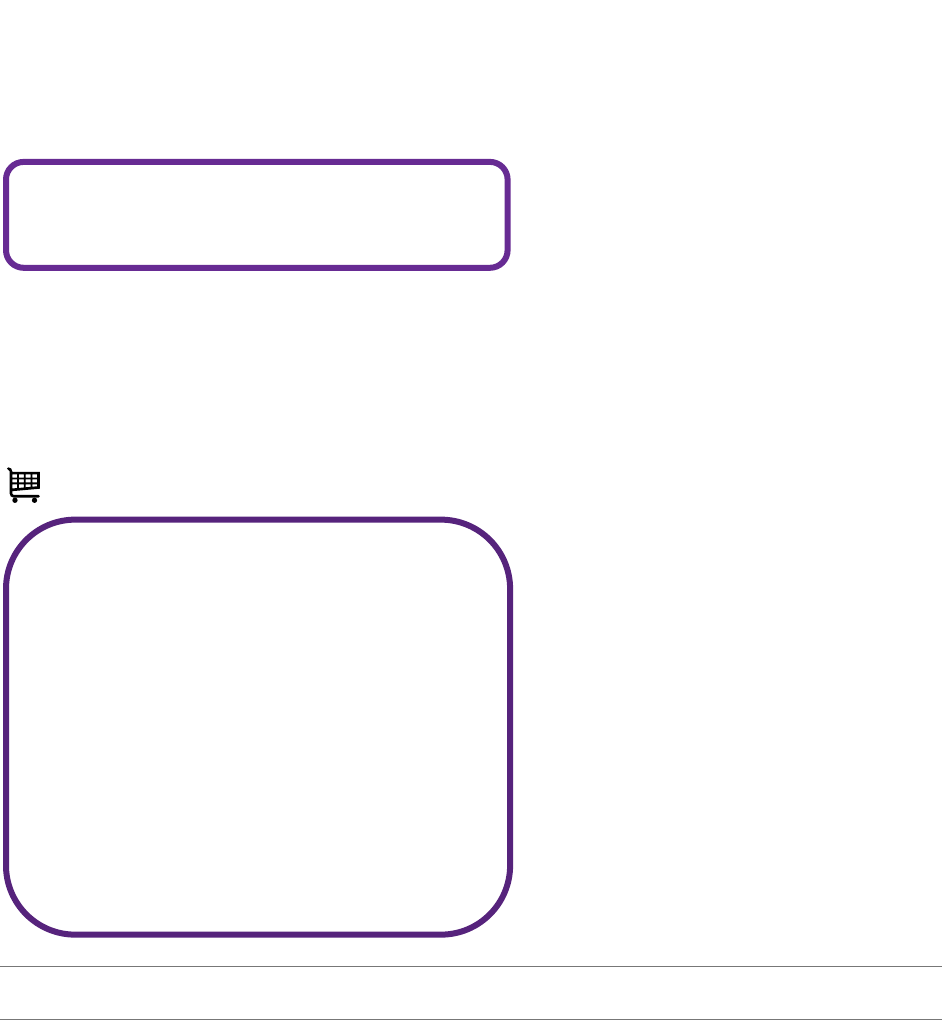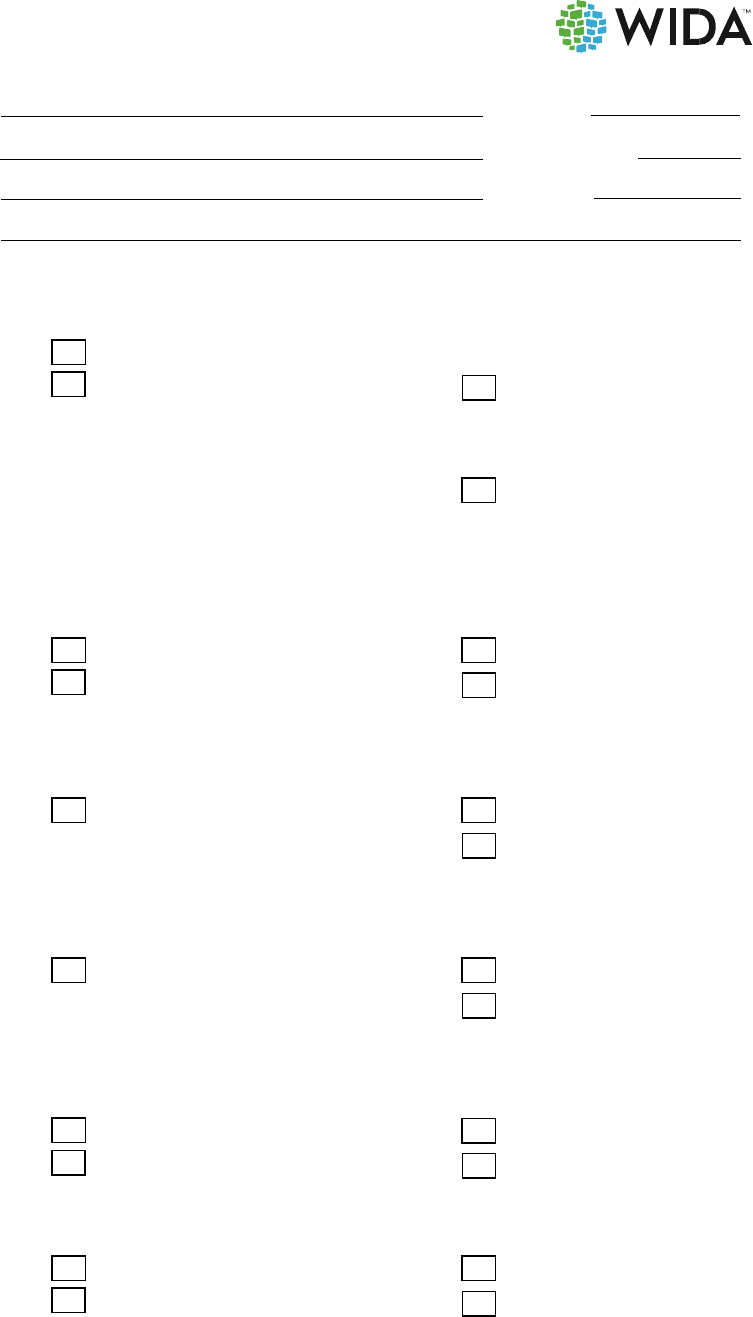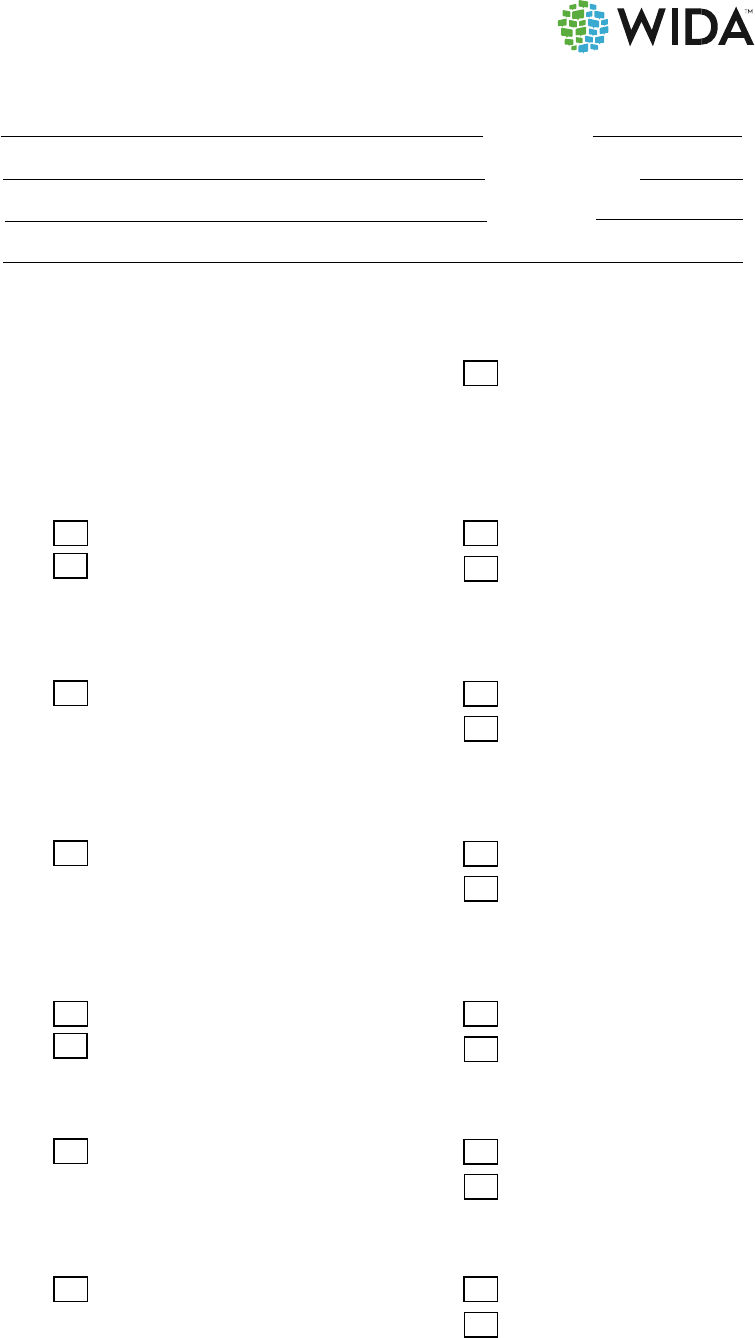
2024-2025
Accessibility &
Accommodations
Manual
ACCESS for ELLs
Kindergarten ACCESS for ELLs • ACCESS for ELLs Paper
ACCESS for ELLs Online • WIDA Alternate ACCESS
WIDA Screener
WIDA Screener for Kindergarten • WIDA Screener Paper • WIDA Screener Online
Contents
How to Use This Manual ............................................................................................................................. i
Critical Contact Information ................................................................................................................. i
Participation Decisions for WIDA Assessments ................................................................................ ii
Accessibility and Accommodations Overview ........................................................................................ 1
The WIDA Accessibility and Accommodations Framework .............................................................. 1
Universal Design ................................................................................................................................ 2
Administrative Considerations ........................................................................................................ 3
Test Timing and Scheduling ........................................................................................................ 3
Test Environment .......................................................................................................................... 4
Test Content Presentation .......................................................................................................... 4
Test Item Responses .................................................................................................................... 5
Universal Tools ................................................................................................................................... 5
Audio aids ....................................................................................................................................... 6
Color preferences ......................................................................................................................... 6
Highlighters, colored pencils, or crayons ................................................................................... 7
Keyboard navigation ..................................................................................................................... 7
Line guide or tracking tool ........................................................................................................... 7
Low-vision aids or magnification devices .................................................................................. 7
Scratch paper and notepad ......................................................................................................... 8
Accommodations ............................................................................................................................... 9
Braille (BR) ..................................................................................................................................... 11
Extended Speaking test response time (ES) ........................................................................... 12
Extended testing of a test domain over multiple days (EM) ................................................ 13
In-person human reader (IR) ..................................................................................................... 13
Repeat in-person human reader (RP) ..................................................................................... 14
Interpreter signs test directions in ASL (SD) .......................................................................... 15
Large print (LP)........................................................................................................................... 15
Manual control of item audio (MC) .......................................................................................... 16
Repeat item audio (RA) .............................................................................................................. 17
Scribe (SR) ................................................................................................................................... 18
Recording device and transcription (RD) ................................................................................ 18
Test administered in a non-school setting (NS) .................................................................... 19
© 2024 Board of Regents of the University of Wisconsin System, on behalf of WIDA. Last revised June 2024
Word processor or similar keyboarding device (WD) ........................................................... 20
Specific Circumstances ............................................................................................................................ 21
Significant Cognitive Disability ........................................................................................................... 21
WIDA Alternate ACCESS Participation Decision Tree .............................................................. 22
Deafness or Hard of Hearing ............................................................................................................ 23
Blindness or Visual Impairment ......................................................................................................... 23
Use of Augmentative Communication Devices ............................................................................. 24
Domain-Specific Testing Exemptions ............................................................................................. 24
Domain Exemption Decision Tree ................................................................................................ 25
Appendix A: Keyboard Navigation ........................................................................................................ 26
Appendix B: Transcription ....................................................................................................................... 27
Appendix C: Scribing .............................................................................................................................. 29
Appendix D: Checklists ............................................................................................................................ 31

Always follow state-specific accessibility and accommodation policies for English language proficiency tests.
State guidance may vary from the recommendations in this document.
i
How to Use This Manual
This manual guides you through the selection and provision of accessibility supports and
accommodations for ACCESS for ELLs and WIDA Screener testing. District and school administrative
staff, educators, support staff, and members of decision-making teams, including those responsible for
Individualized Education Programs (IEPs), 504 Plans, and support for students covered under Title II of
the Americans with Disabilities Act (ADA), should be familiar with this guidance and reference it as they
prepare for testing.
Critical Contact Information
When issues arise, refer to this manual, visit your member/state page of the WIDA website, and work with
your test coordinator as well as any designated student support staff. If you have questions after
consulting those resources, we’re here to help! WIDA Client Services Center staff are experts in
accessing WIDA materials and administering WIDA tests. Our technology and test processing partner,
Data Recognition Corporation (DRC), can address concerns about managing student data and test
materials.
Topic of Concern
Contact
• State-specific policies and procedures
• Scheduling and material logistics
• Test irregularities or potential security breaches
• State-specific accommodations policies
Your state education agency representative
Name:
Email:
Phone:
Website:
• WIDA Secure Portal and training courses
• Test administration procedures
• Accommodations and accessibility guidance
• Understanding score reports
WIDA Client Services Center
866-276-7735
• Test registrations in WIDA AMS
• Accessing score reports in WIDA AMS
• Online testing in DRC INSIGHT
• Test booklet labels
• Damaged test booklets
DRC Customer Service
855-787-9615
TTY: 763-268-2889
Use this document along with the test-specific test administrator manual, and always follow your
state-specific accessibility and accommodation policies for English language proficiency testing.
The recommendations in this document do not replace or amend state policy.

Always follow state-specific accessibility and accommodation policies for English language proficiency tests.
State guidance may vary from the recommendations in this document.
ii
Participation Decisions for WIDA Assessments
The WIDA test design process and allowed supports help to ensure that WIDA assessments are
accessible to all students who need to take English language proficiency assessments, including those
with disabilities. See The WIDA Accessibility and Accommodations Framework
topic for detail on the
ways you can meet students’ diverse needs during testing.
For students with the most significant cognitive disabilities, WIDA has created WIDA Alternate ACCESS.
See the Significant Cognitive Disability
section for details on the participation criteria for this
assessment.

Always follow state-specific accessibility and accommodation policies for English language proficiency tests.
State guidance may vary from the recommendations in this document.
1
Accessibility and Accommodations Overview
The testing process must always be both valid and reliable to ensure meaningful assessment of a
student’s academic English language proficiency (ELP). This is true for a standard test administration,
and it is also true for the individualized approach necessary to allow students with particular learning
challenges or disabilities to engage with the test.
To ensure the validity, reliability, and administration security of ACCESS for ELLs and WIDA Screener,
only the accessibility supports and accommodations identified in this document should be used during
test administration. The use of accessibility supports and accommodations not described in this
document can compromise the validity of the assessment and invalidate students’ results.
ELP assessments measure a different set of knowledge, skills, and abilities than content tests do. As a
result, some supports available to all students taking an ELP assessment might be considered
accommodations on a content test. For example, graphic support for reading passages and modeling of
appropriate responses are standard features of WIDA assessments but might not be typical of content
tests.
The opposite is also true: some supports that are typically available to English learners taking a content
test are not acceptable supports on an ELP assessment. For example, use of a bilingual dictionary or the
option to provide American Sign Language responses instead of verbal responses might be typical for a
language arts or science test, but these options would not produce valid results in the context of an ELP
assessment.
The following modifications would alter the set of knowledge, skills, and abilities ACCESS for ELLs and
WIDA Screener measure. While they might be useful for classroom instruction, they are never allowed
during test administration.
• Reading aloud items on the Reading domain test
• Providing oral or written translations of items into a language other than English
• Allowing responses in a language other than English
• Signing items, passages, or response options
• Allowing use of a bilingual word-to-word dictionary
The WIDA Accessibility and Accommodations Framework
WIDA’s approach to accessibility and accommodations prioritizes student engagement from the
beginning and ensures that all students can engage fully and appropriately with the test.
WIDA’s assessments are rooted in the understanding that:
• English learners (ELs) have diverse learning needs and styles.
• All ELs are capable of making progress toward English language proficiency.

Always follow state-specific accessibility and accommodation policies for English language proficiency tests.
State guidance may vary from the recommendations in this document.
2
• To effectively collaborate on content-related, grade-appropriate tasks, ELs must acquire
discipline-specific language practices so that they can interpret and produce context-
appropriate language and fully participate in academic contexts.
With these considerations in mind, WIDA’s test development process incorporates universal design
principles that increase accessibility for all test takers. Universal design encourages the use of graphic
support, scaffolding, and thematic grouping of items to make it easier for all learners to engage with test
content and show what they can do.
Administrative considerations are always available to any student who might benefit from some
personalization of standard test procedures, such as a familiar test environment or an extra break.
Administrative considerations must be selected prior to the test and are provided by test administrators,
test coordinators, and other support staff.
Universal tools provide increased accessibility and can be used by any student at any time. These
supports often align with tools readily available in a typical school or home learning environment, such as
scratch paper, highlighters, or line guides.
Finally, for those who have an identified and documented disability, accommodations provide targeted
support. Accommodations are typically available only to students with Individualized Education Programs
(IEPs) or 504 Plans.
Universal Design
The WIDA Accessibility and Accommodations Framework is built on a foundation of universal design
features that include test content presented in multiple modalities, item prompts with supportive
graphics, embedded scaffolding, and modeled responses to guide students’ language use. Variety in how
information is presented, as well as how students interact with test content, help minimize the factors

Always follow state-specific accessibility and accommodation policies for English language proficiency tests.
State guidance may vary from the recommendations in this document.
3
that could prevent students from fully showing what they can do in terms of the set of knowledge, skills,
and abilities the test is designed to assess.
For example, in the ACCESS for ELLs Online Writing test, audio embedded in the test platform makes a
multimodal presentation of tasks the default format. Students both see and hear task instructions,
helping to ensure that students have a chance to demonstrate their writing skills and are not
disadvantaged solely by a still-developing ability to read or to listen.
Administrative Considerations
Individualized administration procedures give educators the flexibility they need to provide optimal
testing conditions. These considerations can be extended to any test taker and, in most cases, must be
facilitated by the test administrator. Critically, the administrative considerations described in this
document do not change what the test measures or the way scores are interpreted and used.
The administration of WIDA Alternate ACCESS allows for a wide variety of administrative considerations
to meet the individual needs of students taking the test. See the
Alternate ACCESS: Administration and
Scoring training course and the ACCESS for ELLs Test Administrator Manual for additional guidance.
Test Timing and Scheduling
Note: The online testing platform will automatically log students out of the session after 30 minutes of
inactivity.
• Supervised Breaks. Any student may take a break at any point, as needed. These breaks might
be planned in advance based on student-specific needs, such as a tendency to quickly become
fatigued or anxious during testing. Whenever possible, keep the student in the testing
environment during breaks. Have the student pause the online test or close any open test
booklets before standing up, stretching, or walking around the room. If the student must leave
the testing environment, for example to go to the restroom, access medical equipment, or take a
sensory break, ensure the student is escorted and that interaction with other students is
minimized. This administrative consideration must not interfere with the testing experience of
any other student.
• Short Segments. In the rare circumstance that a student needs longer breaks than described
above, you can administer the test in multiple short administration sessions that are
predetermined and based on breaks in classroom instruction familiar to the student. Each
language domain test should be completed within one school day. WIDA recommends using the
paper-format test with this administration format. Test administrators must collect and securely
store all test materials between testing segments.
• Extended Testing Time. WIDA’s assessments are not timed tests. Timing guidance is provided
for scheduling and planning purposes and is not intended to be a strict limit. Typically, a planned
extended testing session is one and a half times the recommended testing time. However, any
student who is actively engaged in testing can continue working up to the end of the school day.

Always follow state-specific accessibility and accommodation policies for English language proficiency tests.
State guidance may vary from the recommendations in this document.
4
Note that for the Speaking test, extended speaking response time is an available
accommodation.
Test Environment
• Adaptive and Specialized Equipment or Furniture. Students who routinely use adaptive or
specialized furniture or equipment—such as special seating, weighted vests, fidget tools, noise-
reducing headphones, specialized lighting or acoustics, or adaptive keyboards— should have
access to this equipment during testing. If the student’s use of this equipment will be a
distraction to other students, arrange an individual test administration. Students who are
uncomfortable using a headset may use an alternative microphone, such as the one built into the
testing device or an external microphone that is connected to the testing device and compatible
with the test platform. If the student’s use of an alternative microphone setup will be a distraction
to other students, arrange an individual test administration. Test the technology set-up and
provide students an opportunity to practice prior to testing day.
• Familiar Test Administrator. The test can be administered by any person the student is
comfortable with, provided the individual is trained and certified to administer the test.
• Individual or Small Group Setting. Test students in any group size that makes them most
comfortable, that reflects their typical classroom environment, or that follows any group size
guidelines documented in an IEP or 504 Plan.
• Medical Device. Students who use an electronic device for medical purposes (for example, a
glucose monitor or hearing aid) may have access to the device during testing. This applies even if
the device is one that is typically not permitted while testing, such as a smartphone or
smartwatch. The device should only support the student for medical reasons and the test
administrator must closely monitor the use of the device to maintain test security.
• Specific Seating. Seat students any place in the testing environment that helps them hear, see,
focus, or otherwise engage with the test. For example, students might do their best when seated
near or away from a window or vent, or near the test administrator. Seating arrangements must
ensure the student can access test materials, hear the test administrator and any recorded audio,
and be monitored.
Test Content Presentation
• Test Format. Depending on state testing policies, students may use either the online or paper
format of the test to address individual student needs. For example, you can give a student the
pencil-and-paper delivered test even though students throughout the school or district typically
test in the online test platform. Keep in mind:

Always follow state-specific accessibility and accommodation policies for English language proficiency tests.
State guidance may vary from the recommendations in this document.
5
o A paper-based format is available for students taking the online test to handwrite
answers on the Writing test in grades 4–12. See the test-specific Test Administrator
Manual for details and check your state’s testing policies before offering this option.
o When students take WIDA Alternate ACCESS, test administrators may adapt the
Listening, Reading, and Speaking Test Booklet to present item responses in a format
that meets individual student needs. See the
ACCESS for ELLs Test Administrator
Manual for details.
• Redirection. Quietly, without disturbing other test takers, direct a student’s attention to the test
when the student is demonstrating off-task behavior. Do not coach the student on test-taking
skills or offer guidance on how to respond to a question. You can redirect the student in English
or in the student’s home language.
• Encouragement. Quietly, without disturbing other test takers, offer verbal praise for on-task
behavior. For example, say “Good job!” after the student completes an item or a section of the
test. Offer encouragement regardless of the accuracy of a student’s answer. Encouragement
must not be tied to the student’s test performance.
• Read Aloud to Self. Students may read any part of the test aloud to themselves, with or without
the use of a device such as a whisper or fluency phone. If the student’s reading will be a
distraction to other students, arrange an individual test administration.
Test Item Responses
• Monitor Placement of Responses. Test administrators may monitor students as they test to
ensure that answers are marked in the correct location. For example, test administrators can
intervene to ensure students do not mistakenly select or change an answer while using keyboard
navigation in the online test platform, or to ensure students do not skip questions or mistakenly
mark the wrong location in a paper test booklet.
o Don’t confirm or correct students’ responses. Never provide or change a response for a
student.
o Don’t answer questions about content or language. Instead, remind students to do their
best.
Universal Tools
Universal tools are always available to all test takers. They are embedded in the online test platform as
digital features. Test administrators provide physical versions of universal tools to students taking the
paper test.
Help students determine when a tool is both appropriate and useful. Tools can reinforce a student’s
ability to demonstrate their language skills, but only if the student is comfortable using the tool. As you
prepare students for testing, help them make connections between the tools they use in the classroom

Always follow state-specific accessibility and accommodation policies for English language proficiency tests.
State guidance may vary from the recommendations in this document.
6
and the universal tools that will be available to them during testing. Give students opportunities to
practice using available tools on sample items or tasks similar to testing. Check out the
Preparing
Students for ACCESS for ELLs Online document for details on how you and your students can practice
using the embedded universal tools prior to testing day.
Audio aids
Audio aids include amplification devices, noise buffers, and white noise machines. These tools can be
provided by the school or by the student. These tools are generally appropriate only if the student
typically uses such devices during instruction or assessment, and they must be compatible with the
requirements of the test. For example, noise-reducing headphones must still allow the student to hear
test items that are read aloud by a test administrator or presented as recorded audio.
CONSIDERATIONS FOR ONLINE TESTING: Students with a hearing aid or cochlear implant may utilize
Bluetooth functions between their personal amplification device and the testing device, if compatible.
See the Supported Systems Requirements for ACCESS for ELLs and Screener
guide for more
information. Be sure to test connections prior to testing. If the headphones and headset required for
testing are not compatible with a personal audio amplification device, such as a hearing aid or cochlear
implants, test the student individually in a separate room and use the speakers in the testing device or
external speakers.
Color preferences
Students can use transparent color overlays to alter how they see the test content in a test booklet or on
a screen. These tools, provided by the school or by the student, can increase contrast or otherwise allow
students to better see the test content.
CONSIDERATIONS FOR ONLINE TESTING: A variety of defined color adjustment options are built into
the test platform. They are accessed by clicking on the gear icon in the top right corner of the screen.
The options include black on white, black on cream, dark gray on light gray, and brown on pink.
Universal tools do not need to be pre-selected in WIDA AMS, WIDA’s test management platform.
States and districts determine whether test administrators have WIDA AMS accounts. Refer to the
ACCESS for ELLs Checklist on your member/state page of the
WIDA website for detailed
information on your role and whether your responsibilities include using WIDA AMS.

Always follow state-specific accessibility and accommodation policies for English language proficiency tests.
State guidance may vary from the recommendations in this document.
7
Explore the settings yourself before introducing them to students. Let students practice using the tools
in advance so they are ready to make a selection and focus during testing. Keep in mind that students
might adjust settings throughout testing, depending on what is on the screen.
Highlighters, colored pencils, or crayons
Students can use a variety of tools to mark specific text.
CONSIDERATIONS FOR ONLINE TESTING: A highlighter tool is built into the test platform. Mouse
control is needed to use this tool.
CONSIDERATIONS FOR PAPER TESTING: Students can use any tool for highlighting, but responses
must be marked with a number 2 pencil only.
Keyboard navigation
Students can move from screen to screen and make selections in the online test platform using a
keyboard instead of a mouse. See Appendix A
for details.
CONSIDERATIONS FOR ONLINE TESTING: Keyboard navigation does not allow students to manipulate
interactive items or the built-in universal tools. Explore this option yourself before introducing it to
students.
Line guide or tracking tool
Students can use a variety of tools to guide their eyes while reading. Tracking tools used in the
classroom, such as note cards, bookmarks, or sentence highlighting strips, can be used during testing as
long as they do not contain text or notation in any language.
CONSIDERATIONS FOR ONLINE TESTING: A line guide tool is built into the test platform. Activate the
tool, and then drag the graphic that appears on the screen to move the line guide. Mouse control is
needed to use this tool.
CONSIDERATIONS FOR PAPER TESTING: Any line guide tool that adheres to the test booklet, such as
highlighting tape, must be removed before the test booklet is returned.
Low-vision aids or magnification devices
Students can interact with enlarged graphics and text to complete testing. Explore your options for
enlargement well in advance of testing to determine what works best for the student, and be sure to have
them practice using the feature in Test Practice before taking the actual test.
CONSIDERATIONS FOR ONLINE TESTING: A magnifier tool is built into the test platform. Students
must scroll to see all the content when the test is magnified, and they must return to the default size to

Always follow state-specific accessibility and accommodation policies for English language proficiency tests.
State guidance may vary from the recommendations in this document.
8
use other tools, such as the highlighter. A large monitor might display a big enough text size to minimize
the need for the magnifier tool.
Testing with an iPad? Use the pinch-to-zoom feature as usual and select the magnifier tool to return to the
default display size.
CONSIDERATIONS FOR PAPER TESTING: Students can use a low-vision device with a regular or large
print test booklet. Answers recorded in a large print booklet must be transcribed.
Scratch paper and notepad
Students can make notes, draft text, or sketch diagrams as they test. This content is never scored.
Scratch paper can be any blank writing surface, including plain or color paper, grid paper, ruled paper,
braille paper, raised-line paper, or even a dry-erase board. Do not provide any graphic organizers. If
allowed by state-specific policy, scratch paper can be used as a universal tool on any domain test at the
student’s request. Students can use any writing utensil on scratch paper, but responses must always be
marked with a number 2 pencil.
Used scratch paper is considered secure test material. Test administrators must collect used
scratch paper and completely erase dry-erase boards at the end of each domain test. Scratch paper
must be securely destroyed.
CONSIDERATIONS FOR ONLINE TESTING: A notepad tool is built into the test platform for the Writing
test. Select the tool, and a notepad window will open. Notes are added by typing on the keyboard. The
notepad can be closed and reopened, and stays on the screen on which it’s created as the student moves
through the test. The notepad can be used instead of, or in addition to, physical scratch paper.

Always follow state-specific accessibility and accommodation policies for English language proficiency tests.
State guidance may vary from the recommendations in this document.
9
Accommodations
Accommodations are changes to test materials or testing procedures. They do not change what the test
measures. Accommodations increase equitable access and help students overcome the effects of a
disability. In other words, they allow students to show their knowledge, skills, and abilities without making
the test easier. Accommodations do not affect validity or reliability, so they do not change how you can
interpret and use scores.
Accommodations on ACCESS assessments are intended only for students with disabilities as
documented in an IEP or 504 Plan. Accommodations decisions are made by a student’s
educational support team (IEP, 504, or Title II of the ADA). They should never be assigned
unilaterally by an individual educator outside of the IEP process. In very rare cases,
accommodations are assigned for students who do not have IEPs or 504 Plans. For example, an
accommodation could address a short-term barrier associated with an unforeseeable circumstance, such
as a student with a fractured hand who needs a scribe or a student recovering from illness or injury who
needs to test in a non-school location. Check with your state department of education before
assigning accommodations in these rare situations.
Select accommodations carefully. The goal is not to offer every student every possible support, but
rather to offer specific accommodations as necessary to ensure students can participate in testing
meaningfully and appropriately. Keep in mind that it may be appropriate to offer different
accommodations for different language domain tests. Assign accommodations based on a student’s
actual need as it relates to a particular domain, not simply due to the nature or type of disability.
Accommodations vary slightly on the online and paper formats of the assessments. Some students with
disabilities may need accommodations presented in an alternate format. For example, some students
may need to have accommodations delivered by a test administrator rather than the online test platform.
Keep in mind that it may be appropriate to provide an alternative format to these students.
Consider these questions as you assign accommodations:
• Does the student use an accommodation regularly in the classroom? If not, consider
carefully whether an accommodation is truly needed for testing. Accommodations should not be
provided for the first time in a testing situation. Students should be given opportunities to
practice the accommodation prior to the assessment.
• Does the accommodation address the student’s need? Accommodations do not reduce
expectations or compensate for a lack of knowledge, skills, or prior instruction. The sole purpose
of an accommodation is to ensure that a disability does not prevent a demonstration of English
language proficiency. “More is better” is not the right approach. Providing unnecessary
accommodations can negatively impact student performance.
• Is the accommodation appropriate for ELP testing? Some accommodations that are
typically available to English learners taking a content test are not acceptable supports on an

Always follow state-specific accessibility and accommodation policies for English language proficiency tests.
State guidance may vary from the recommendations in this document.
10
ELP assessment. Student support teams must never offer an accommodation that would
invalidate the ELP assessment.
The purpose of WIDA assessments is to measure a student’s English language proficiency. Therefore,
these accommodations are never allowed in WIDA ELP testing:
• Bilingual word-to-word dictionaries
• A test administrator reading aloud any part of the Reading test
• Providing test items in a language other than English
• Allowing responses in a language other than English
The team making accommodations decisions and planning testing for a student with documented
disabilities should be multidisciplinary and collaborative. It should include individuals with expertise in
second language acquisition. It is helpful to include those who understand how to differentiate between
limited English proficiency and a disability. Document testing arrangements, including accommodations,
in the student’s records.
All physical materials necessary for accommodation—such as braille materials, assistive technology, or
manipulatives—must be identified in advance. Student support teams must work closely with test
coordinators to ensure that all appropriate materials are ordered if necessary and available for testing.
Support teams must work closely with test administrators to ensure that all planned accommodations are
provided as intended. If appropriate accommodations are not provided, the test results may not be a
valid measure of the student’s abilities.
Each allowed accommodation is listed on the following pages, and includes a description of how it is
administered in both the online and paper formats. When you document these accommodations for
Some online testing accommodations must be selected in WIDA AMS, WIDA’s test
management platform, prior to testing, to ensure that the functionality is enabled for the
student at the time of testing.
States and districts determine who has a WIDA AMS account. Talk to your Test Coordinator to
learn whether your responsibilities include using WIDA AMS.
Accommodations that must be pre-selected in WIDA AMS are marked with an arrow.
Some accommodation-related materials must be ordered prior to testing. States and districts
determine the process for special orders of test materials. Refer to the contact information on
your member/state page of the WIDA website
, and check with the appropriate individuals
before ordering materials.
Accommodations that must be ordered are marked with a shopping cart.

Always follow state-specific accessibility and accommodation policies for English language proficiency tests.
State guidance may vary from the recommendations in this document.
11
testing, they are noted in the student score data file provided to state education agencies with the codes
shown in parentheses.
In the rare case that a student’s documented disability requires the use of an accommodation
not described in the following section, contact your state education agency with a unique
accommodations request.
Braille (BR)
Materials must be ordered
Unified English Braille (UEB) is available on tests for grades 1–5. Both UEB with Nemeth and UEB
Math/Science are available on tests for grades 6–12. Specify UEB with Nemeth or UEB Math/Science, as
well as contracted or uncontracted braille, when you order materials. Confirm students are proficient in
the braille code selected prior to assigning this accommodation. WIDA recommends that the results of
the braille assessment be used with caution since braille proficiency may confound the assessment of
English language proficiency. IEP teams are strongly encouraged to use multiple sources of information
along with results of the braille assessment when making decisions for reclassification.
When providing this accommodation, WIDA recommends arranging an individual test administration. Plan
to extend the test session as needed based on the student’s braille proficiency and reading speed. WIDA
suggests planning twice the standard test administration session time for a braille administration.
Each braille test kit contains an embossed test booklet, a standard test booklet for transcription, a test
administrator script, a speaking test booklet, sample items with a user guide, and a CD of audio files. (The
sample items and user guide are also available for download from the
ACCESS Test Practice and Sample
Items section of the WIDA website.) The embossed test booklet contains tactile graphics, labels, picture
descriptions, and transcriber’s notes. Translating picture descriptions into a student’s home language is
appropriate, as doing so will provide the student with the same support available to sighted test takers.
This accommodation is available for:
ACCESS for ELLs Paper
In these domains:
Listening
Reading
Writing

Always follow state-specific accessibility and accommodation policies for English language proficiency tests.
State guidance may vary from the recommendations in this document.
12
Note that WIDA does not recommend use of the Speaking test with braille administrations, but the
Speaking test booklet is included in the kit, since state policies may vary.
Ideally, the test administrator providing this accommodation is proficient in braille. If allowed
under your state testing policies, this test administrator could be a special education teacher or a teacher
of the blind or visually impaired instead of an ELP educator. All test administrators must complete the
training in the WIDA Secure Portal.
Students may record answers on the embossed test booklet, on blank braille paper, or by using a braille
writing tool or braille notetaker. In the Listening and Reading tests, students may dictate as the test
administrator transcribes answers into the standard test booklet.
The student’s responses must be transcribed verbatim into the standard test booklet by an individual
who is proficient in the braille code selected. Return both the embossed test booklet and the standard
test booklet at the end of testing. Only the standard booklet will be scanned and scored. See Appendix B
for transcription guidance.
Extended Speaking test response time (ES)
This option must be pre-selected
This accommodation provides additional time for cognitive processing or motor planning for speaking.
This accommodation may support students with cognitive, language processing, physical, or
communication disabilities who need additional processing time for spoken language.
When this accommodation is selected in WIDA AMS for an online-format test, the online test platform
allows twice the standard response time for each Speaking task.
When test administrators provide this accommodation for a pencil-and-paper-format test, they pause
the Listening and Speaking CD after the audio file plays to allow the student time to respond.
This accommodation is available for:
ACCESS for ELLs Paper
ACCESS for ELLs Online
WIDA Screener Paper
WIDA Screener Online
In this domain:
Speaking

Always follow state-specific accessibility and accommodation policies for English language proficiency tests.
State guidance may vary from the recommendations in this document.
13
Extended testing of a test domain over multiple days (EM)
In the extremely rare situation that a single domain test administration must extend across multiple days,
seek the approval of a state assessment official to offer this accommodation.
In-person human reader (IR)
Materials must be ordered
This accommodation applies only to text. Test administrators read labels or captions but never
describe images (except when reading the graphic descriptions in the administrator’s notes of the
consolidated TA scripts for the braille assessments only). Answer choices may be read aloud only
during the Listening domain tests.
This accommodation may support students with a documented need for an in-person human reader. For
example, this may include needs related to reading/print or focusing attention. The paper test materials
may be used to provide lip reading support.
• When test administrators provide this accommodation for an online test, they supplement the
pre-recorded audio by reading text answer choices and text labels in graphics. Test
administrators also read all text that appears on screen for the grades 4-12 writing tasks. There is
This accommodation is available for:
all tests, all domains
This accommodation is available for:
ACCESS for ELLs Paper
ACCESS for ELLs Online
WIDA Screener Paper
WIDA Screener Online
In these domains:
Listening
Speaking
Writing

Always follow state-specific accessibility and accommodation policies for English language proficiency tests.
State guidance may vary from the recommendations in this document.
14
no additional script when providing this accommodation for computer-delivered tests, so
materials do not need to be ordered for online tests for students in grades 4-12.
• When test administrators provide this accommodation for WIDA Screener Paper, they read from
the appropriate recording script, available by emailing the WIDA Store at
store@wceps.org
. Test administrators also read instructions, test items, text answer choices,
and text labels in graphics labels exactly as they appear in the test booklet.
• When test administrators provide this accommodation for ACCESS for ELLs Paper, they read
from the Human Reader Accommodation Script, which must be ordered specially in advance of
testing. The Human Reader Accommodation Script substitutes for the Listening and Speaking
CD, and is used instead of the Test Administrator Script for all domain tests. To order this item,
collect the information you have about the student for whom this accommodation applies. Then
contact DRC Customer Service and order this item during your additional materials
ordering window. For the Listening and Speaking tests, schedule two test administrators for
each test whenever possible. An extra test administrator allows the adults to read the scripted
dialogue between an example student and the primary test administrator. For the Writing test,
the test administrator reads all the text in the test booklet.
Providing this accommodation to one student must not interfere with the testing experience of any other
student. Whenever possible, provide this accommodation by arranging an individual test administration
or a small group session that includes only students who are receiving this accommodation.
Repeat in-person human reader (RP)
Materials must be ordered
This accommodation is available for:
ACCESS for ELLs Paper
ACCESS for ELLs Online
WIDA Screener Paper
WIDA Screener Online
In these domains:
Listening
Speaking
Writing

Always follow state-specific accessibility and accommodation policies for English language proficiency tests.
State guidance may vary from the recommendations in this document.
15
When test administrators provide this accommodation, they follow the guidelines for the IR
accommodation and may repeat anything they read aloud. This accommodation applies only to text. Test
administrators read labels or captions but never describe images (except when reading the graphic
descriptions in the administrator’s notes of the consolidated TA scripts for the braille assessments
only). During a Listening domain test, test administrators can repeat the listening passage and test
questions only once. There is no additional script when providing this accommodation for computer-
delivered tests, so materials do not need to be ordered for online tests for students in grades 4-12.
This accommodation may support students with a documented need for an in-person human reader. For
example, this may include needs related to reading/print or focusing attention.
Providing this accommodation to one student must not interfere with the testing experience of any other
student. Whenever possible, provide this accommodation by arranging an individual test administration
or a small group session that includes only students who are receiving this accommodation.
Interpreter signs test directions in ASL (SD)
Translation of actual test items is not allowed. To provide this accommodation, arrange for an
interpreter to sign test logistics, directions, and practice items into ASL or another signed system. ASL is
a complete and organized visual language that is considered a separate language from English. Consider
offering this accommodation to new test takers who need the opportunity to understand test logistics.
Large print (LP)
Materials must be ordered
This accommodation is available for:
all tests, all domains
This accommodation is available for:
Kindergarten ACCESS for ELLs
ACCESS for ELLs Paper
In these domains:
Listening
Reading
Speaking
Writing

Always follow state-specific accessibility and accommodation policies for English language proficiency tests.
State guidance may vary from the recommendations in this document.
16
Large print test materials are printed in 18-point font on 11x17 paper. Large print test kits must be
specially ordered, and they include everything required to administer the test. Student responses
recorded on large print materials must be transcribed verbatim into the scannable test booklets for
scoring. Return both booklets at the end of testing. Only the booklet for transcription will be scanned and
scored. See Appendix B for transcription guidance. Note that WIDA Alternate ACCESS is already
printed in 18 point font or larger, and a separate large print version is not available. Materials
may be enlarged locally, as needed.
Manual control of item audio (MC)
This option must be pre-selected
This accommodation allows students to indicate when they are ready to hear recorded audio during
testing. This accommodation may support students who need additional time for language processing,
attention, or focus needs due to a disability. Note that this accommodation does not apply when
administrators read from a script, including the Writing domain for grades 1-3. When using the MC
accommodation in DRC INSIGHT, the Repeat item audio (RA) accommodation is also activated, and
allows students to hear recorded audio a second time.
• To provide this accommodation for an online test, select it in WIDA AMS prior to testing.
Students will see, and must click, a Play button on every screen where audio would otherwise play
automatically. Once the student clicks Play, the audio cannot be paused or stopped.
• When test administrators provide this accommodation for a paper test, they ask students
whether they are ready to listen before playing any track of the Listening and Speaking CD. Test
This accommodation is available for:
ACCESS for ELLs Paper
ACCESS for ELLs Online
WIDA Screener Paper
WIDA Screener Online
In these domains:
Listening
Speaking
Writing

Always follow state-specific accessibility and accommodation policies for English language proficiency tests.
State guidance may vary from the recommendations in this document.
17
administrators should practice prior to testing so they are comfortable with the equipment they
will use. Administration of this accommodation must not disturb or interfere with other students.
Repeat item audio (RA)
This option must be pre-selected
This accommodation allows students to hear recorded audio a second time. This accommodation may
support students who need repetition for language processing, attention, or focus needs due to a
disability. Note that this accommodation does not apply when administrators read from a script, including
the Writing domain for grades 1-3. When using this accommodation in DRC INSIGHT, the Manual control
of item audio (MC) accommodation is also activated, and allows students to indicate when they are ready
to hear recorded audio during testing.
• To provide this accommodation for an online test, select this option in WIDA AMS prior to
testing. Students will see, and must click, a Repeat button on every screen where audio can be
repeated. Once the student clicks Repeat, the audio cannot be paused or stopped. Students can
click the Repeat button to replay the audio one time in the Listening test. In the Speaking and
Writing tests, students can click the Repeat button to replay the audio as many times as needed.
• When test administrators provide this accommodation for a paper test, they ask students
whether they are ready to listen to the audio of the Listening and Speaking CD. When students
indicate they are ready to hear the audio again, test administrators replay the track. In a
Listening test, test administrators may replay the audio only once. In a Speaking test, test
administrators repeat the process until the student is ready to move on. Test administrators
This accommodation is available for:
ACCESS for ELLs Paper
ACCESS for ELLs Online
WIDA Screener Paper
WIDA Screener Online
In these domains:
Listening
Speaking
Writing

Always follow state-specific accessibility and accommodation policies for English language proficiency tests.
State guidance may vary from the recommendations in this document.
18
should practice prior to testing so they are comfortable with the equipment they will use.
Administration of this accommodation must not disturb or interfere with other students.
Scribe (SR)
To provide this accommodation, a test administrator or another designated individual responds in the
online test platform or in a test booklet as directed by a student. For example, a student might provide
verbal dictation of a Writing response, which the scribe types or writes. A student might indicate a
response to a multiple-choice question using a speech-to-text device, using a picture or word board, by
pointing, or with eye gaze, and the scribe selects or marks the option indicated.
Consider offering this accommodation to students who routinely rely on dictation or scribing for written
compositions during classroom instruction. In rare cases, a scribe accommodation might be an
appropriate response to a temporary disability, such as a broken arm or hand.
An individual test administration must be used to provide this accommodation. When students
are new to the process of scribing, practice prior to testing is especially important.
Responses must be scribed verbatim at the time of testing. See Appendix C for Scribe Guidance.
Recording device and transcription (RD)
This accommodation may support students with writing processing issues by separating the process of
responding from the process of writing. When using this accommodation, the student responds to test
tasks by speaking into a recording device. As soon as possible after completing the test, the student
This accommodation is available for:
all tests
In these domains:
Listening
Reading
Writing
This accommodation is available for:
all tests
In this domain:
Writing

Always follow state-specific accessibility and accommodation policies for English language proficiency tests.
State guidance may vary from the recommendations in this document.
19
transcribes the responses into the test platform or a test booklet. Check state policy for timeframe
expectations.
• If response and transcription are completed in the same testing session, the student may edit the
responses as they transcribe.
• If response and transcription are completed in separate testing sessions, the student must
transcribe the responses verbatim. Test administrators must closely monitor student
transcriptions to ensure fidelity to the original answer.
To provide this accommodation, arrange for the student to bring a familiar recording device to the
testing session. Students must be comfortable with using the device of their choice, and they
must be familiar with the transcription process. Always arrange an individual test
administration to provide this accommodation.
Recording devices must be stored securely in a locked location between testing sessions. After
transcription is complete, all content must be deleted from the recording device.
Test administered in a non-school setting (NS)
In the extremely rare situation that an enrolled student is unable to attend school due to hospitalization
or another extended absence during the testing window, the test may be administered in a non-school
setting. Please contact your state education agency for more information about required approvals. This
accommodation must follow all security requirements and be provided by school personnel
who are trained test administrators.
For online test administration, a designated technology coordinator must configure a school-owned
laptop by installing all software necessary for online testing. Whenever feasible, test the configuration
and connectivity in the planned testing environment prior to testing.
This accommodation is available for:
all tests, all domains

Always follow state-specific accessibility and accommodation policies for English language proficiency tests.
State guidance may vary from the recommendations in this document.
20
Word processor or similar keyboarding device (WD)
This accommodation is appropriate for students who have a documented need to use a specific,
standalone word processor or other keyboarding device that is not compatible with the online test
platform or the testing device.
This accommodation is not necessary for students whose use of a specialty keyboard, adaptive mouse, or
any other piece of equipment allows them to interact with the online test platform or paper test
materials. Use of adaptive or specialized furniture or equipment is an administrative consideration that
can be extended to any student.
To provide this accommodation, arrange for the student to bring their device to the testing session. For a
Writing test, the test administrator must confirm that any spelling or grammar checking function is turned
off, that any dictionary or thesaurus features are disabled, and that the device is not connected to the
internet.
Student responses recorded on the device must be transcribed into the online test platform or
a test booklet as soon as possible after each domain test is complete. See Appendix B for
transcription guidance.
Whenever possible, print the student’s responses for transcription and then delete all content
from the device. If printing is not an option, the keyboarding device must be stored securely in
a locked location until transcription is complete and all content has been deleted. After
transcription, securely destroy any printed original responses that have been transcribed.
This accommodation is available for:
all tests
In these domains:
Listening
Reading
Writing

Always follow state-specific accessibility and accommodation policies for English language proficiency tests.
State guidance may vary from the recommendations in this document.
21
Specific Circumstances
The scenarios below are a few examples of specific circumstances that require special consideration as
you plan for testing.
Significant Cognitive Disability
Check with your state education agency on specific criteria for identifying students with
significant cognitive disabilities. An English learner who is identified with significant cognitive
disabilities and who is unable to take ACCESS for ELLs, even with accommodations, can be considered
for participation in WIDA Alternate ACCESS. This assessment is designed for ELs who participate, or
would be likely to participate, in a state’s alternate content assessments. Student support teams should
consider carefully whether ACCESS for ELLs or WIDA Alternate ACCESS would best allow a student to
demonstrate developing English language skills.

Always follow state-specific accessibility and accommodation policies for English language proficiency tests.
State guidance may vary from the recommendations in this document.
22
WIDA Alternate ACCESS Participation Decision Tree
Assessment participation decisions must be made by an IEP team, not an individual. Check with your
state education agency on specific criteria for identifying ELs with significant cognitive disabilities.

Always follow state-specific accessibility and accommodation policies for English language proficiency tests.
State guidance may vary from the recommendations in this document.
23
Deafness or Hard of Hearing
Consider carefully how an EL identified as deaf or hard of hearing can participate in testing. The options
available in this scenario depend on local testing policies and the student’s unique needs. Remember,
ASL is a complete and organized visual language that is separate from English. Students who are deaf or
hard of hearing, including those who primarily use ASL for communication, may participate in Reading
and Writing tests with few or no accommodations. The In-Person Human Reader accommodation might
be appropriate during the Listening test for students who use speech reading as part of their
communication system.
Students who are deaf or hard of hearing are not required to take an assessment’s pencil-and-paper
delivered mode, but WIDA recommends it for several reasons. There are more opportunities for speech
reading on the pencil-and-paper delivered assessment, especially on the Listening test. It is easier to
provide test directions in manually coded English. ACCESS for ELLs Paper also eliminates the need to
submit an incomplete domain or override tier placement.
Keep in mind that mixed-mode testing is not allowed. Students cannot take the online format of
one domain and the paper format of a different domain. While some students, including those in grades
1-3, handwrite Writing responses as part of a standard administration of ACCESS for ELLs Online or
WIDA Screener Online, that is not considered mixed-mode testing. Determine in advance which test
delivery mode will be most practical to administer and best allow the student to demonstrate English
language skills.
Your state testing policies may allow for some form of manually coded English to provide access to the
Listening and Speaking domains for ELs who are deaf, including cued speech, finger spelling (Rochester
Method), Visible English, Seeing Essential English (SEE I), Signing Exact English (SEE II), or Signed
English. Work with your state education agency to determine which, if any, manual language supports are
allowed for ELs who are deaf or hard of hearing.
Blindness or Visual Impairment
ELs with low vision can often participate fully in online testing, using a large display and the magnification
tool built into the test platform. If the IEP team determines the pencil-and-paper test is a better option
for the student, assistive technologies such as a CCTV or document camera can enlarge the test content
beyond the standard sized booklet. A large print format is also available.
Keep in mind that mixed-mode testing is not allowed. Students cannot take the online format of
one domain and the paper format of a different domain. While some students, including those in grades
1-3, handwrite Writing responses as part of a standard administration of ACCESS for ELLs Online or
WIDA Screener Online, that is not considered mixed-mode testing. Determine in advance which test
delivery mode will be most practical to administer and best allow the student to demonstrate English
language skills.

Always follow state-specific accessibility and accommodation policies for English language proficiency tests.
State guidance may vary from the recommendations in this document.
24
Students proficient in braille can participate in the Listening, Reading, and Writing test in braille format.
WIDA does not offer a braille Speaking test and does not recommend administering this language
domain at this time. See the braille accommodation description for detail.
Guidance for WIDA Screener
For additional information on administering WIDA Screener to students identified as deaf or hard of
hearing, or blind or visually impaired, please refer to the WIDA Screener: Blind/Visually Impaired and
Deaf/Hard of Hearing Administration Guidance on the WIDA website.
Use of Augmentative Communication Devices
An augmentative/alternative communication (AAC) device is considered the voice of a student who is
unable to produce functional speech. Use of an AAC during testing should be consistent with the
student’s day-to-day instruction and communication methods and is not considered an accommodation.
It is rare for individual sounds to be programmed into AAC devices, so test administrators must be
prepared to accept non-standard responses from students using these tools. For example, if a test item
asks a student to produce the isolated phoneme /g/, the student would simply indicate the correct letter
instead of producing the sound. Additionally, available vocabulary might impact the student’s ability to
respond to specific test items. For example, if a student is asked to identify an apple but does not have
the word “apple” available in the device, the student could offer the more generic word “fruit,” point to
indicate an answer choice, or use another response method.
Never provide a page on the AAC device specifically for ELP testing. This action would invalidate
the student’s scores, as the student’s responses would not reflect their day-to-day academic English
language skills. This accommodation should always be provided by a test administrator who is familiar
with the student’s classroom communication and use of the AAC device.
Domain-Specific Testing Exemptions
State and federal laws require all ELs to participate in annual ELP assessment. No disability
exempts a student from this requirement. However, when all appropriate accommodations have been
offered and the student’s disability remains a barrier to assessing a particular language domain, the
student may be exempted from that individual domain test. Contact your state education agency prior to
making a domain exemption. Refer to the Test Coordinator Manual for details on marking a Do Not Score
code to indicate that a student is not participating in a particular domain test.

Always follow state-specific accessibility and accommodation policies for English language proficiency tests.
State guidance may vary from the recommendations in this document.
25
Domain Exemption Decision Tree

Always follow state-specific accessibility and accommodation policies for English language proficiency tests.
State guidance may vary from the recommendations in this document.
26
Appendix A: Keyboard Navigation
Keyboard navigation of the DRC INSIGHT test platform works with a Windows, Mac, or Linux operating
system and is available for touchscreens and devices such as iPads and Chromebooks. Keyboard
navigation does not allow a user to manipulate interactive test items or built-in tools, but a scribe or test
administrator may help a student access them.
Keystroke
Function
Enter/return Selects Sign In button when username and password are entered.
Tab
Transfers the focus, indicated by a dark blue outline, from one button to another.
Tab order: Help, Options, Exit, Back/Next, Highlighter, Notepad, Magnifier, Line
Guide, Pause
Shift + Tab
Transfers the focus, indicated by a dark blue outline, from one button to another in
the opposite direction of Tab.
Enter/return/
space bar
Activates or deactivates the tool or function that is in focus.
Ctrl + Tab
Switches between multiple active windows on the screen. For example, if both the
options and help windows are open, use Ctrl + Tab to switch between them.
Esc Closes the magnifier tool, help window, and options menu.
Alt + X Selects the Exit button when the test is paused.
Arrows
Transfers the focus from one option to another within a list of choices, such as
multiple-choice options, tabs within the help window, or color tools in the options
menu.
Alt + P Selects the Pause button.
Alt + B Selects the Back button.
Alt + N Selects the Next button.
Alt + O Selects the Options button.
Ctrl + A Selects all the text in a Writing response window.
Ctrl + X Cuts the selected text in a Writing response window.
Ctrl + C Copies the selected text in a Writing response window.
Ctrl + V
Pastes the previously copied or cut text at the cursor location in a Writing response
window.
Ctrl + U Underlines the selected text in a Writing response window.

Always follow state-specific accessibility and accommodation policies for English language proficiency tests.
State guidance may vary from the recommendations in this document.
27
Appendix B: Transcription
Student responses must be transcribed into a standard test booklet in a variety of situations, such as
when a student provides responses in a comparable format (e.g., word processor or braille), or a test
booklet is soiled.
Transcribers must:
Be trained by a representative of the state or local education agency
Sign the WIDA Secure Portal Non-Disclosure and User Agreement
Be proficient in written English
Be able to decode the student’s handwriting
In addition, braille transcribers must be proficient in the braille code used by the student. Ideally, all
transcribers are familiar with the student’s handwriting and have experience transcribing for the student
outside of the testing context.
• Transcribe student responses verbatim as soon as possible after testing. Ensure all test content
stored on recording or word processing devices is deleted after transcription.
• At least two individuals must be present during the transcription process. At least one of the
individuals must be a certified test administrator. One of the individuals transcribes the student
responses, and the other individual observes to confirm the accuracy of the transcription. Note:
Where transcription is part of the test administration, such as with Kindergarten ACCESS for
ELLs and WIDA Alternate ACCESS, it is not necessary to have a second person present for
transcription.
• Place a Pre-ID label or District/School label on the transcribed booklet and complete the student
demographic information in number 2 pencil. Return the booklet with the rest of your test
materials.
• Prepare any test booklet that contains student responses but should not be scored for return:
o On the front cover, write “Transcribed. Do not score.”
o Place a Do Not Process label on the booklet, as shown in Figure 1 on the next page.
o Return both the transcribed booklet and the nonscorable booklet.
• Document the security barcode of any soiled booklet in WIDA AMS. Refer to the
Test
Coordinator Manual for details on this process. Securely destroy the soiled booklet.

Always follow state-specific accessibility and accommodation policies for English language proficiency tests.
State guidance may vary from the recommendations in this document.
28
Figure 1
Preparing a student response booklet that should not be scored

Always follow state-specific accessibility and accommodation policies for English language proficiency tests.
State guidance may vary from the recommendations in this document.
29
Appendix C: Scribing
Scribing is the act of recording responses on behalf of a student. This process happens during test
administration, while the student is present.
Responses are scribed into the online test platform or a standard test booklet when a student receives
this accommodation. When a scribe is used, the student may respond to test items orally, with gestures
or pointing, by eye-gazing, or using an AAC device. Scribing takes place as the student dictates or
produces responses, and responses are entered verbatim. All scribing must be administered individually
and completed within the testing session. This includes any changes the student makes to the dictated
response.
In most cases, students receiving the scribe accommodation should be receiving this service regularly in a
classroom setting. In rare cases, a scribe accommodation might be an appropriate response to a
temporary disability, such as a broken arm or hand. If a student is new to the process of scribing
during a test, practice prior to testing is especially important.
Scribes must:
Complete all training required by the state or local education agency
Sign the WIDA Secure Portal Non-Disclosure and User Agreement
Be proficient in the English language
Be able to produce legible written or typed text
Ideally, individuals providing the Scribe accommodation will have experience scribing for the student
outside of the testing context. Training should provide scribes the opportunity to practice and receive
immediate direct feedback on their scribing practices.
A student using a scribe must be given the same opportunities to interact with the test. At the student’s
request, scribes manipulate universal tools such as the notepad, line guide, or color contrast setting.
Scribes provide the same opportunity the student’s peers have to process test items and plan responses,
which may include writing outlines, plans, or drafts. When using an AAC device, scribes should have
experience with the device and the student. Students are not required to indicate additional conventions
of writing such as spelling, punctuation, and grammar. The scribe may simply record dictated responses
without additional guidance from the student.
• At the student’s request, scribes read a dictated response and the student dictates edits. Scribes
make changes exactly as dictated by the student, even if a change is incorrect. Scribes must not cue
the student to errors when reading the dictated response aloud.
• Scribes may ask students to slow down or repeat a response. Scribes should not record vocalizations
such as “um” or “ahh” that accompany a spoken response.

Always follow state-specific accessibility and accommodation policies for English language proficiency tests.
State guidance may vary from the recommendations in this document.
30
• Scribes may ask, “Are you finished?” or “Is there anything you want to add or delete?” Scribes must
not coach students, influence responses, or suggest that students review responses.
• Scribes may answer procedural questions, such as, “Do I have to fill the entire space?” Scribes must
not confirm answers, prompt students to fix mistakes, or answer content questions, such as “What
does that word mean?”
Questions about scribing should be directed to the SEA.

Always follow state-specific accessibility and accommodation policies for English language proficiency tests.
State guidance may vary from the recommendations in this document.
31
Appendix D: Checklists
On the following pages you can find accommodations checklists for WIDA assessments.

Accommodations: Kindergarten ACCESS for ELLs
Completed by:
Student:
District/School:
Date:
ID number:
Grade:
Team Members:
Accommodations:
1. Extended testing of a test domain over multiple days (EM). Provide written request and
evidence of need to state education agency.
Listening Speaking
Reading
Writing
2. Interpreter signs directions in ASL (SD). Sign administration instructions, test directions,
and practice items. Do not sign scored items.
Listening Speaking
Reading
Writing
3. Large print (LP). Order materials in advance.
Listening Speaking
Reading
Writing
4. Scribe (SR). A trained adult records student responses during testing.
Listening Speaking (not applicable)
Reading
Writing
5. Recording device and transcription (RD). Clear device after transcription.
Listening (not applicable) Speaking (not applicable)
Reading
(not applicable) Writing
6. Test administered in a non-school setting (NS). Provide written request and evidence of
need to state education agency.
Listening Speaking
Reading
Writing
7. Word processor or similar keyboarding device (WD). Clear device after verbatim
transcription.
Listening Speaking (not applicable)
Reading
Writing

Accommodations: ACCESS for ELLs Paper
Completed by:
Student:
District/School:
Date:
ID number:
Grade:
Team Members:
Accommodations:
1. Braille (BR). Grades 1-12; order materials in advance.
Listening Speaking (not applicable)
Reading
Writing
2. Extended Speaking test response time (ES)
Listening (not applicable) Speaking
Reading
(not applicable) Writing (not applicable)
3. Extended testing of a test domain over multiple days (EM). Provide written request and
evidence of need to state education agency.
Listening Speaking
Reading
Writing
4. In-person human reader (IR). Read item text, graphics labels, and answer choices exactly as
they appear.
Listening Speaking
Reading
(not applicable) Writing
5. Repeat in-person human reader (RP). Read item text, graphics labels, and answer choices
exactly as they appear and repeat once at student request.
Listening Speaking
Reading
(not applicable) Writing
6. Interpreter signs directions in ASL (SD). Sign administration instructions, test directions,
and practice items. Do not sign scored items.
Listening Speaking
Reading
Writing
7. Large print (LP). Order materials in advance.
Listening Speaking
Reading
Writing

Accommodations: ACCESS for ELLs Paper
(continued)
Student:
8. Manual control of item audio (MC)
Listening Speaking
Reading
(not applicable) Writing
9. Repeat item audio (RA)
Listening Speaking
Reading
(not applicable) Writing
10. Scribe (SR). A trained adult records student responses during testing.
Listening Speaking (not applicable)
Reading
Writing
11. Recording device and transcription (RD). Clear device after transcription.
Listening (not applicable) Speaking (not applicable)
Reading
(not applicable) Writing
12. Test administered in a non-school setting (NS). Provide written request and evidence of
need to state education agency.
Listening Speaking
Reading
Writing
13. Word processor or similar keyboarding device (WD). Clear device after verbatim
transcription.
Listening Speaking (not applicable)
Reading
Writing

Accommodations: ACCESS for ELLs Online
Completed by:
Student:
District/School:
Date:
ID number:
Grade:
Team Members:
Accommodations:
1. Extended Speaking test response time (ES). Pre-select in WIDA AMS.
Listening (not applicable) Speaking
Reading
(not applicable) Writing (not applicable)
2. Extended testing of a test domain over multiple days (EM). Provide written request and
evidence of need to state education agency.
Listening Speaking
Reading
Writing
3. In-person human reader (IR). Read item text, graphics labels, and answer choices exactly as
they appear.
Listening Speaking
Reading
(not applicable) Writing
4. Repeat in-person human reader (RP). Read item text, graphics labels, and answer choices
exactly as they appear and repeat once at student request.
Listening Speaking
Reading
(not applicable) Writing
5. Interpreter signs directions in ASL (SD). Sign administration instructions, test directions,
and practice items. Do not sign scored items.
Listening Speaking
Reading
Writing
6. Manual control of item audio (MC). Pre-select in WIDA AMS.
Listening Speaking
Reading
(not applicable) Writing
7. Repeat item audio (RA). Pre-select in WIDA AMS.
Listening Speaking
Reading
(not applicable) Writing

Accommodations: ACCESS for ELLs Online
(continued)
Student:
8. Scribe (SR). A trained adult records student responses during testing.
Listening Speaking (not applicable)
Reading
Writing
9. Recording device and transcription (RD). Clear device after transcription.
Listening (not applicable) Speaking (not applicable)
Reading
(not applicable) Writing
10. Test administered in a non-school setting (NS). Provide written request and evidence of
need to state education agency.
Listening Speaking
Reading
Writing
11. Word processor or similar keyboarding device (WD). Clear device after verbatim
transcription.
Listening Speaking (not applicable)
Reading
Writing

Accommodations: WIDA Alternate ACCESS
Completed by:
Student:
District/School:
Date:
ID number:
Grade:
Team Members:
Accommodations:
1. Extended testing of a test domain over multiple days (EM). Provide written request and
evidence of need to state education agency.
Listening Speaking
Reading
Writing
2. Interpreter signs directions in ASL (SD). Sign administration instructions, test directions,
and practice items. Do not sign scored items.
Listening Speaking
Reading
Writing
3. Scribe (SR). A trained adult records student responses during testing.
Listening Speaking (not applicable)
Reading
Writing
4. Recording device and transcription (RD). Clear device after transcription.
Listening (not applicable) Speaking (not applicable)
Reading
(not applicable) Writing
5. Test administered in a non-school setting (NS). Provide written request and evidence of
need to state education agency.
Listening Speaking
Reading
Writing
6. Word processor or similar keyboarding device (WD). Clear device after verbatim
transcription.
Listening Speaking (not applicable)
Reading
Writing

Accommodations: WIDA Screener for Kindergarten
Completed by:
Student:
District/School:
Date:
ID number:
Grade:
Team Members:
Accommodations:
1. Extended testing of a test domain over multiple days (EM). Provide written request and
evidence of need to state education agency.
Listening Speaking
Reading
Writing
2. Interpreter signs directions in ASL (SD). Sign administration instructions, test directions,
and practice items. Do not sign scored items.
Listening Speaking
Reading
Writing
3. Scribe (SR). A trained adult records student responses during testing.
Listening Speaking (not applicable)
Reading
Writing
4. Recording device and transcription (RD). Clear device after transcription.
Listening (not applicable) Speaking (not applicable)
Reading
(not applicable) Writing
5. Test administered in a non-school setting (NS). Provide written request and evidence of
need to state education agency.
Listening Speaking
Reading
Writing
6. Word processor or similar keyboarding device (WD). Clear device after verbatim
transcription.
Listening Speaking (not applicable)
Reading
Writing

Accommodations: WIDA Screener Paper
Completed by:
Student:
District/School:
Date:
ID number:
Grade:
Team Members:
Accommodations:
1. Extended Speaking test response time (ES)
Listening (not applicable) Speaking
Reading
(not applicable) Writing (not applicable)
2. Extended testing of a test domain over multiple days (EM). Provide written request and
evidence of need to state education agency.
Listening Speaking
Reading
Writing
3. In-person human reader (IR). Read item text, graphics labels, and answer choices exactly as
they appear.
Listening Speaking
Reading
(not applicable) Writing
4. Repeat in-person human reader (RP). Read item text, graphics labels, and answer choices
exactly as they appear and repeat once at student request.
Listening Speaking
Reading
(not applicable) Writing
5. Interpreter signs directions in ASL (SD). Sign administration instructions, test directions,
and practice items. Do not sign scored items.
Listening Speaking
Reading
Writing
6. Manual control of item audio (MC). Included in test design.
Listening Speaking
Reading
(not applicable) Writing
7. Repeat item audio (RA). Included in test design.
Listening Speaking
Reading
(not applicable) Writing

Accommodations: WIDA Screener Paper
(continued)
Student:
8. Scribe (SR). A trained adult records student responses during testing.
Listening Speaking (not applicable)
Reading
Writing
9. Recording device and transcription (RD). Clear device after transcription.
Listening (not applicable) Speaking (not applicable)
Reading
(not applicable) Writing
10. Test administered in a non-school setting (NS). Provide written request and evidence of
need to state education agency.
Listening Speaking
Reading
Writing
11. Word processor or similar keyboarding device (WD). Clear device after verbatim
transcription.
Listening Speaking (not applicable)
Reading
Writing

Accommodations: WIDA Screener Online
Completed by:
Student:
District/School:
Date:
ID number:
Grade:
Team Members:
Accommodations:
1. Extended Speaking test response time (ES). Pre-select in WIDA AMS.
Listening (not applicable) Speaking
Reading
(not applicable) Writing (not applicable)
2. Extended testing of a test domain over multiple days (EM). Provide written request and
evidence of need to state education agency.
Listening Speaking
Reading
Writing
3. In-person human reader (IR). Read item text, graphics labels, and answer choices exactly as
they appear.
Listening Speaking
Reading
(not applicable) Writing
4. Repeat in-person human reader (RP). Read item text, graphics labels, and answer choices
exactly as they appear and repeat once at student request.
Listening Speaking
Reading
(not applicable) Writing
5. Interpreter signs directions in ASL (SD). Sign administration instructions, test directions,
and practice items. Do not sign scored items.
Listening Speaking
Reading
Writing
6. Manual control of item audio (MC). Pre-select in WIDA AMS.
Listening Speaking
Reading
(not applicable) Writing
7. Repeat item audio (RA). Pre-select in WIDA AMS.
Listening Speaking
Reading
(not applicable) Writing

Accommodations: WIDA Screener Online
(continued)
Student:
8. Scribe (SR). A trained adult records student responses during testing.
Listening Speaking (not applicable)
Reading
Writing
9. Recording device and transcription (RD). Clear device after transcription.
Listening (not applicable) Speaking (not applicable)
Reading
(not applicable) Writing
10. Test administered in a non-school setting (NS). Provide written request and evidence of
need to state education agency.
Listening Speaking
Reading
Writing
11. Word processor or similar keyboarding device (WD). Clear device after verbatim
transcription.
Listening Speaking (not applicable)
Reading
Writing
